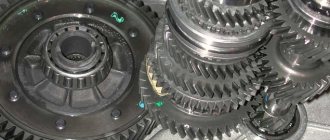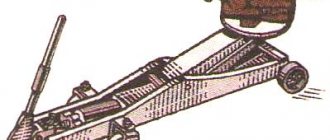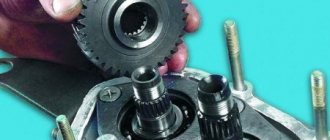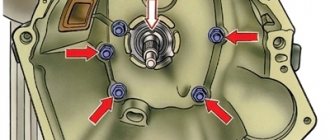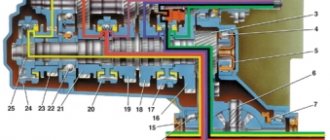02/26/2022 20,775 Transmission
Author: Victor
In any car, the gearbox is one of the main units. And if we are talking about KamAZ, then it is also a complex device. This material will help you understand the design features, as well as how to change gears on a KamAZ and what not to do.
[Hide]
Box modifications
The type of box installed depends on the loads the vehicle experiences and the conditions in which it is operated:
- KPP-14;
- KPP-15;
- KPP-16;
- KamAZ ZF gearbox.
The fourteenth transmission is a five-speed device, which includes a gearbox. The fifteenth modification of the product with ten stages, unlike KamAZ-14, is equipped with a divider with two stages, the device is located in the front part of the box.
Gearbox KamAZ-14:
Transmissions are controlled mechanically, remotely, using a swing lever located on the power plant. The mechanical gearbox is controlled by pneumatics and mechanics, through a selector. The driver directly acts on the rocker.
The sixteenth gearbox, with eight shift stages, is of mechanical type. The design includes a four-stage gearbox and a reduction box mounted behind the structure.
The base of the rod that switches the stages is installed on the gearbox plug; the lever itself is made in an original design solution. The product contains a rod that controls the gearbox, a lever, a safety net that prevents erroneous start of reverse, and valves controlled by pneumatics and switching a mechanism that increases torque.
Gearbox KamAZ - 15:
The ZF gearbox on KamAZ with nine stages is equipped with an auxiliary reduction gear, unlike the 16 model.
The KamAZ 5320 gearbox is equipped with five stages. Since the equipment is operated in harsh conditions, it is equipped with large gear ratios for operation at low speeds. Switching occurs in stages, the transmission easily adapts to road conditions.
KamAZ ZF gearbox:
Gear controls on modern cars are different. A mechanism with fewer gears is used on vehicles with a smaller load capacity and dimensions. Modifications of 10 stages are installed on road trains. KamAZ is in demand in 40 countries because the control mechanisms are reliable and durable.
Driving on an icy road
A special feature of driving on icy routes is the use of chains on the wheels of the car. The measures will increase the coefficient of road adhesion.
Take into account:
- Keep your distance, leave room for maneuver;
- When braking, use the brake assist system;
- Remember, emergency braking on a KamAZ truck leads to blocking of the trailer wheels.
It is not advisable to use emergency braking, as this will lead to skidding and uncontrolled movement. When skidding, keep your foot on the clutch pedal and turn the steering wheel in the direction of the skid, this will level the car.
What is needed to extend the life of the gearbox
In order to avoid damage, you must follow the operating recommendations given by the manufacturer.
It is necessary to shift gears correctly, in accordance with the diagrams (double or cascade H).
It is also important to regularly check the transmission oil level and change it every 30 thousand km. Manufacturers always inform you about what oil is needed for a specific gearbox model.
In winter, it is very important to warm up the gearbox, otherwise the thickened oil will not be able to lubricate the parts well enough, which will lead to their premature wear.
You should always start driving in 1st gear; shifting should be done with the clutch disengaged.
Timely maintenance is also important, during which all transmission elements are checked and, if necessary, adjusted.
Description of gearboxes
Structurally, the ten-speed transmission is a box with five steps and a gearbox. This design uses 10 forward gears and 2 reverse gears. The transmission is popular and is used for installation on vehicles carrying heavy loads. The mechanism received index 15.
Distinctive features of the KamAZ-15 box:
- Used in conjunction with a reinforced divider synchronizer;
- The splines have been modernized and strengthened, the fastening parts have been removed from the box;
- The fixation of transmission gears has been modernized;
- The height of the teeth has been increased.
Downshift (divider) valve for KamAZ-15:
The pneumatic system activates and controls the KamAZ transmission dividing device. The performance and durability of the unit directly depends on the correct use of this unit. For the same reason, inspection of the KamAZ transmission is carried out at specialized stations.
KamAZ transmission elements:
- Box body with built-in shafts: driving, driven, intermediate;
- Gear mechanism for activating reverse;
- Upper casing;
- Collapsible mechanism that switches stages;
- The power unit is located in the front of the body.
Specifications
The KamAZ gearbox with a divider includes the following elements:
- a crankcase in which the drive, driven and intermediate shafts assembled with gears are mounted;
- bearings;
- synchronizers,
- reverse gear block,
- top cover of the box,
- gear shift mechanism.
The gearbox of KamAZ vehicles can be five- or ten-speed. The gearbox divider has high and low gears and, in combination with the main gearbox, allows for 10 forward gears and 2 reverse gears. The divider system improves the traction qualities of the machine, makes it easier to control, and reduces the frequency of shifting gears with a lever. Transmission ratios are available in the operating instructions for the device.
The 141 KamAZ gearbox has a reversing light switch. To prevent the simultaneous activation of 2 gears, there is a ball-type lock in the cover, and a spring-finger fuse is used to prevent accidental engagement of reverse gear. The gearbox with divider weighs 320 kg. The cuffs are located in the shaft covers. They protect the gearbox from clogging and prevent oil leakage. Insufficient oil volume in the gearbox leads to its damage. When you first fill the gearbox there should be 9 liters of oil, when changing the fluid - 8 liters.
Technical characteristics of the KamAZ-141 gearbox: Carter:
- The diameter of the bearing bore is 150 mm.
- The diameter of the hole in the gear block axis is 32 mm.
Main shaft:
- The diameter of the front bearing journal is 24 mm.
- Rear bearing - 59 mm.
The secondary shaft has the following diameters for the parts:
- Fourth gear gear bushings - 63 mm.
- Roller bearings - 80 mm.
- Reverse gear bushings - 70 mm.
- The outer diameter of the sleeve is 72 mm.
Intermediate shaft:
- The diameter of the front bearing journal is 65 mm, the rear one is 49 mm.
- The diameter of the rear bearing cup is 119 mm.
- The diameter of the intermediate shaft is 65 mm.
- The inner diameter of the gear is 65 mm.
The weight of the gearbox with divider is 320 kg.
Box divider
High and low operating modes, a feature of KamAZ gearboxes. This specificity is caused by the desire to reduce the load on the power plant. It is typical that it does not matter whether the machine is loaded or not. A divider is a gearbox based on the principle of mechanics and increases gear ratios. The mechanism is started using a switch on the rocker.
The design includes:
KamAZ-15 box divider input shaft:
- The valve that controls the device. The part is attached to the base of the switch, uses direct and reduced speed modes.
- A valve that maintains a constant outlet pressure. It takes compressed air and resets the pressure in the system when the established values are exceeded. Transfers air to the control valve and to the valve of the dividing device from the air unit. Thanks to manipulations, there are simultaneously two circuits in the engine control system.
- Divider activation valve. Supplies air pressure to the device when the clutch is disconnected. This engages and disengages low gear, paralleling the transmission's gear changes.
- Dividing mechanism. The composition includes a piston placed inside a cylinder. The piston lever is connected to a rod fixed to the fork shaft of the assembly. When air pressure hits, the piston moves, this changes the operating mode of the box.
- The air distribution pipe supplies air pressure to the cylinder of the unit.
Reverse
On the Russian KamAZ, not only the front, but also the rear gears are switched on, and there can be two of the latter (if we are talking about a ten-speed gearbox, for example, on a model 55102 truck). The switching diagram clearly shows that to activate reverse gear, you must move the gearshift lever to the lower left position.
Important - it is strictly forbidden to engage reverse while driving. You must first stop the car and only then switch the lever to the appropriate position.
Technical parameters of KamAZ gearboxes
The transmission of KamAZ vehicles is equipped with gearboxes that differ in gear ratios. For this reason, cars are used in many areas. The gear ratios are shown in the table below.
| Box modification | Gear/gear ratios | ||||||||||
| 1 | 2 | 3 | 4 | 5 | 6 | 7 | 8 | 9 | Reverse | ||
| 141 | 5,62 | 2,89 | 1,64 | 1,00 | 0,724 | – | – | – | – | 5,30 | |
| 142 | 6,38 | 3,29 | 2,04 | 1,25 | 0,815 | – | – | – | – | 6,02 | |
| 144 | 7,82 | 4,03 | 2,5 | 1,53 | 1,00 | – | – | – | – | 7,38 | |
| 152 | Increased | 7,82 | 4,03 | 2,5 | 1,53 | 1,00 | – | – | – | – | 7,38 |
| Reduced | 6,38 | 3,29 | 2,04 | 1,25 | 0,815 | – | – | – | – | 6,02 | |
| 154 | Increased | 7,82 | 4,03 | 2,5 | 1,53 | 1,00 | – | – | – | – | 7,38 |
| Reduced | 6,38 | 3,29 | 2,04 | 1,25 | 0,815 | – | – | – | – | 6,02 | |
| 161 | 8,39 | 5,50 | 3,93 | 2,87 | 2,12 | 1,40 | 1,00 | 0,73 | – | 11,01 | |
| ZF-9S109 | 10.24 | 6.576 | 4.78 | 3.531 | 2.61 | 1.86 | 1.35 | 1.0 | 0.74 | 9.44 | |
| ZF-6S1000 | 6.75 | 3.60 | 2.12 | 1.39 | 1.00 | 0.78 | – | – | – | 6.06 | |
| ZF-16S151 | Increased | 13.80 | 9.59 | 6.81 | 4.58 | 3.021 | 2.09 | 1.49 | 1.00 | – | 13.17 |
| Reduced | 11.55 | 8.02 | 5.70 | 3.84 | 2.52 | 1.75 | 1.24 | 0.84 | – | 11.03 | |
| ZF-9S1310 | 9.48 | 6.58 | 4.68 | 3.48 | 2.62 | 1.89 | 1.35 | 1.00 | 0.75 | 8.97 | |
In addition to gear ratios, the characteristics of the box modifications differ structurally. Thus, some models are equipped with parts and components that are not available in other modifications. ZF transmissions are assembled at the Russian plant, together with German partners, at the ZF-KAMA plant in Naberezhnye Chelny.
ZF gearbox repair
Before starting repairs, it is necessary to carry out diagnostics. To do this, you need to set the error code, correlate it with the type of malfunction and its possible cause. In some cases, you can fix the problem yourself, but since the gearbox is a complex device, it is better to entrust the repair to professionals.
In order to repair the transmission, you must first disassemble the gearbox:
- Remove the gear shift assembly: unscrew the M8 screws from the shift housing, remove the housing and seals, remove the thrust plate and spring
- Remove the bearing mounting flange: loosen the mounting screws, remove the flanges and seals
- Disassembling the shafts and rods: unscrew the plugs with the seal, remove the springs and pins from the crankcase, remove the screws around the perimeter of the crankcase. Loosen the locknut on the PTO flange. Pull out the needle bearings and the central control shaft. Remove the output shaft and gear shift forks.
In the process, you can reassemble parts, replace seals, strengthen connections, and replace worn screws. It is also necessary to remove any oil residue.
Based on the fault code, you can find out repair recommendations, for example, if there is a short circuit in the clutch pressure regulator, then you need to check all cables and connections; if a cable is pinched somewhere or there is a break, then this section needs to be changed.
In addition to electronics, transmission malfunctions very often occur, in particular, the synchronizer breaks down. In such cases it must be changed.
Start
The movement starts from the lowest level. The speed change is performed only with the clutch depressed, in several stages. The pattern is associated with upshifts and downshifts, which makes it possible to use the car on different surfaces and terrain.
A successful scheme is considered to be switching 1B-2B-3B when picking up speed, 4H-4B-5H when driving further. When starting, the shaft speed is increased to 7000 min-1, second gear is used after 3000 min-1. The correct operation of the gearbox and its durability depend on strict adherence to the regime on KamAZ 65115 and others. The correct modes reduce fuel consumption, make driving more economical, and extend the life of the power plant.
Gearbox KamAZ 4310 shift diagram:
Switching rules under different conditions
The driver must know how to change gears to control the vehicle:
- on the rise;
- moving on a descent;
- moving on ice and icy areas of the road surface;
- when skidding.
On the rise
Features of KamAZ gearbox control on a hill:
- Driving uphill should be done in high gear;
- To switch from first speed to second, you need to press the clutch pedal twice;
- when performing a maneuver, you must simultaneously depress the gas pedal and the fuel pedal;
- when driving on a hill, you cannot reduce the engine speed to less than 2 thousand per minute (otherwise the engine will stall).
On the descent
Rules for controlling the KamAZ transmission when driving on a descent:
- When driving downhill, do not turn off the engine, since stopping the power unit will cause the power steering to lock.
- When driving downhill, the additional braking system must not be turned off. Also, do not press the clutch pedal all the way.
Modern KamAZ vehicles are equipped with a double-force braking system; accordingly, in addition to engine braking, an additional power unit stopping unit is used. If driving downhill is carried out with the auxiliary braking engaged, then disengaging the clutch and changing gears is not allowed.
Icy areas
Features of driving a KamAZ vehicle on ice and icy road surfaces:
- Driving on ice in a vehicle must be carried out with the maximum allowable speed and travel. Compliance with this nuance will allow you to avoid a traffic accident in an emergency.
- When braking, it is necessary to use the active additional stopping system of the power unit.
- If an emergency occurs while driving, you need to stop the trailer wheels. Otherwise, the car may skid.
- Engine braking is allowed in exceptional cases, as this causes rapid wear of the motor elements. But in emergency situations, such a maneuver will reduce the length of the braking distance.
- When braking, do not allow the wheel to slip. To do this, it is recommended to activate a lower gear in time, since it will reduce the engine crankshaft speed.
During a skid
Rules for using the gearbox during a skid:
- In such a situation, it is not allowed to depress the clutch pedal, as this will lead to a stronger spin.
- During a skid, you need to turn the steering wheel in his direction. In particular, if the body of the car moves to the right, then the steering wheel, accordingly, also scrolls to the right.
- If the car slips during a skid, you must stop moving and turn off the differential axle. The regulator itself for performing this task is located on the instrument cluster. After the device is turned off, the corresponding icon will appear on the dashboard. Then you need to start moving in high gear from second speed.
- After the driver copes with the skid, it is necessary to engage the differential.
Switching Features
If a KamAZ vehicle is driving down a mountain, use high gear. The transition from 1st to 2nd speed occurs by pressing the clutch foot lever twice. The maneuver is accompanied by the addition of gas in order to smooth out the crankshaft speed. If the car goes up, the shaft speed should be 2000 min-1 or higher. Failure to follow this advice will lead to overheating, as well as to stopping and failure of the motor.
The KamAZ transmission is distinguished by its quality, reliability and directional stability during operation. Dividing the box into two modes is used to make the engine easier to move under different vehicle loads. When starting on a loaded vehicle, an increased speed is used, bringing the shaft rotation to 2600 min-1.
Shifting gears on KamAZ (ZF):
Instructions for shifting gearbox
Operation of the transmission includes three main nuances:
- correct start of movement;
- features of selecting and switching speeds;
- using reverse gear.
Getting started: at what speed should you start?
After the engine has been started and the motor has begun to operate, driving should begin in a low gear. When moving away, you only need to engage the speed with the clutch disengaged.
On transmissions of KamAZ vehicles, the gear shift diagram is carried out in a certain sequence:
- At the first stage after starting to move, you need to engage gear 1B (increased first speed mode).
- As the speed increases, the lever switches to 2B mode.
- At the last stage of starting, the 3B gear is activated.
Accordingly, on the main box there is no need to touch the lever up to the fourth speed. To start driving, you need to increase the crankshaft speed to 7 thousand revolutions per minute.
It is important to know
Switching to second gear while driving is possible only after the number of revolutions on the tachometer reaches 3 thousand/min.
How to change speeds correctly?
After acceleration, the order in which the speeds are turned on will be as follows:
- There is a transition to the second lower stage and activation of the fourth speed (4H).
- Then the primary stage is activated, while the movement speed must remain fourth (4B).
- At the next stage, you need to go to a lower gear and activate the fifth speed (5H).
- The driver then returns to the higher gear, but the vehicle continues to move at fifth speed (5B).
How to turn on reverse?
Reverse must be engaged by moving the gearbox lever to the lower left position. Activation of reverse gear is not permitted while driving or if the vehicle is rolling. To engage reverse gear, you need to completely stop the vehicle and then perform the maneuver.
Video: rules for shifting gears on KamAZ
Nikita Vagin in his video spoke in detail about how many speeds there are in KamAZ, as well as about the scheme and nuances of switching them
Caring for the KamAZ gearbox
The device needs to be adjusted and configured, otherwise failures such as difficult shifting and knocking out gears cannot be avoided. Important manipulations include: adjusting the switching mechanism, adjusting the backlash of the rod, adjusting the gap in the divider activation valve, etc.
Checking the oil level in the KamAZ gearbox crankcase:
Changing the lubricant is considered part of the maintenance. The procedure is carried out once a year, mileage does not exceed 90,000 km. When operating the machine in difficult conditions, the lubricant is drained every 45,000 km. or 1000 hours of operation (depending on the established regulations and modification of the box).
Checking the fluid in the 14th and 15th series transmissions is carried out using marks on the neck cover. In the 16th series and ZF, a test hole is used for checking.
Frequent breakdowns include: difficult activation, wear of parts, malfunction of the reverse gear, spontaneous shutdown, etc. Problems are solved by adjusting the mechanism; in case of serious issues, contact a specialist.
Malfunctions and repairs
Transmission repair consists of disassembling the unit, diagnosing, repairing or replacing worn elements. After the mechanism is restored, the unit is reassembled and the system is tested in operation. You can contact a service center, but it is better to repair the transfer case yourself.
How to check the oil level
The oil level in the box is checked as follows. Unscrew the crankcase plug. When checking, you must install the crankcase indicator into the hole until it stops. The oil from the crankcase of a ten-speed manual transmission is drained through 3 holes. Of these, 2 holes are located in the lower part of the gearbox housing, and the third is located in the divider. The five-speed gearbox housing is drained through 2 holes.
Change of oil
To change the oil, you need to wash the gearbox housing with engine oil. Clean the magnetic plugs from metal particles and fill in oil to the top line of the indicator. The oil level is measured after 5 minutes. When the car is moving, the gearbox should operate without hesitation, speeds should be switched freely and locked firmly. Loud noise may indicate worn shaft bearings, insufficient oil level, or poor quality lubricant in the crankcase.
How to remove the box
Removing the gearbox is carried out as follows:
- You need to remove the driveshaft. To do this, unscrew the 4 fastening nuts.
- The PSU is being removed.
- Dismantle the starter mountings.
- Disconnect the tube that goes to the reduction gear.
- Remove the gear shift lever.
- Place a jack between the flywheel and the engine pan, and dismantle the engine through a wooden stand.
- Unscrew the rear yoke nuts and remove it.
- Dismantle the spacer rod.
- Unscrew the exhaust system bracket fastening bolts.
- Connect the hoist to the bolts and tighten it.
- Unscrew the fastening nuts to the side engine mounts.
- Unscrew the bolts that secure the gearbox to the internal combustion engine.
- Raise the hoist and move the gearbox away from the engine to the output of the transmission input shaft.
- Pull out the gearbox.
How to adjust
Now you need to adjust the gearbox and troubleshoot components and parts. If they fail, replace them with new ones. Spline connections must not have defects or chips. Gear bearings should be replaced after first inspecting the place where they are installed to see if there is any wear or areas pressed through by the rollers.
The shaft bearings are replaced because, as a result of breakage and metal shavings getting into the oil, the rolling areas of the bearings were damaged, which could cause gearbox failure. Inspect the gears, detect damage and wear of gear teeth. The conical synchronizer races must not be deformed or worn. The guide shafts should not be loose. There should be no damage to the splines.
How to assemble correctly
The gearbox is assembled in the reverse order. The intermediate shaft is installed in the gearbox housing. Mount the bearings - front roller and rear spherical. Tighten the support washer. Fix it with a nut and close the rear cover of the spherical bearing mount. Install gaskets. The shaft should rotate easily, there should be no jamming of the part when moving.
Repair diagram for KamAZ-5320 gearbox with divider
To repair the KAMAZ-152 gearbox with a divider, it must be disassembled. Analysis includes the following steps:
- To disassemble the box, you will first need to dismantle the air switch and unscrew the fasteners;
- remove the gearbox shift shaft and fork;
- the next step will be to dismantle the fork and release shaft, as well as the synchronizer;
- Next, you need to open the rear bearing cover by unscrewing the screws that first fix it;
- dismantle the bearing and shaft;
- also, to open access to the gearbox multiplier, you will need to remove the support roller washer, metal cup and driven shaft bearing;
- using a rubber (not metal) hammer or a wooden block, you must carefully remove the bearing from the multiplier housing, being careful not to crush the part;
- next you need to remove the coupling and oil injection nuts using the appropriate wrenches;
- The last stage of disassembling the unit is to dismantle the roller bearing, bushing, and gearbox drive gear.
Next, you should inspect all the parts and replace worn ones, and then assemble the device, following the above instructions in reverse order.
How to use a divider on a Kamaz
It is necessary to skillfully combine the divider gears with the gearbox gears.
Acquiring the skills to correctly select gearboxes and dividers can significantly reduce fuel consumption, increase the average speed, create a more economical mode for engine operation, and increase the service life of the clutch, brakes, cardan transmission and drive axles. Gear shifting in the divider is carried out by moving the control valve switch installed in the head of the gear shift lever.
To change gears in the divider, the control valve switch should be moved to the upper or lower position, which corresponds to the highest or lowest gear. Press the clutch pedal all the way and hold it until the gear is fully engaged in the divider (approximately 0.6...0.8 s). When the clutch pedal is pressed all the way, the divider activation valve opens and the divider automatically switches to the selected gear. After this, smoothly release the clutch pedal.
Promotional offers based on your interests:
The control valve switch can be moved to the selected gear position in advance. After this, at the right moment, it is enough to depress the clutch pedal all the way.
When starting the car from a place, the gears in the divider are selected depending on the road conditions and vehicle load.
To accelerate the car to a speed of 10...11 m/s (30...40 km/h) (i.e. to third or fourth gear), it is enough to change the gear in the main box without changing the gear in the divider. To accelerate from third or fourth gear, it is advisable to use both gears of the divider. To do this, when accelerating in difficult road conditions, the following switching sequence is recommended: 1Н—2Н—ЗН—4Н—4В—5Н—5В, when accelerating a car on a paved road—IB—2В—ЗВ—4Н— -5Н-5В.
If during acceleration it is necessary to simultaneously change gears in the main box and the divider, then you should move the switch of the divider control valve to position H, depress the clutch pedal all the way and engage the next higher gear in the gearbox, then smoothly release the clutch pedal.
If the car is moving with the low gear of the divider engaged, and the road resistance has increased and it is necessary to simultaneously change gears in the gearbox and the divider, you should move the divider control valve switch to position B, depress the clutch pedal all the way and engage the next lower gear in the gearbox, then smoothly release the clutch pedal.
